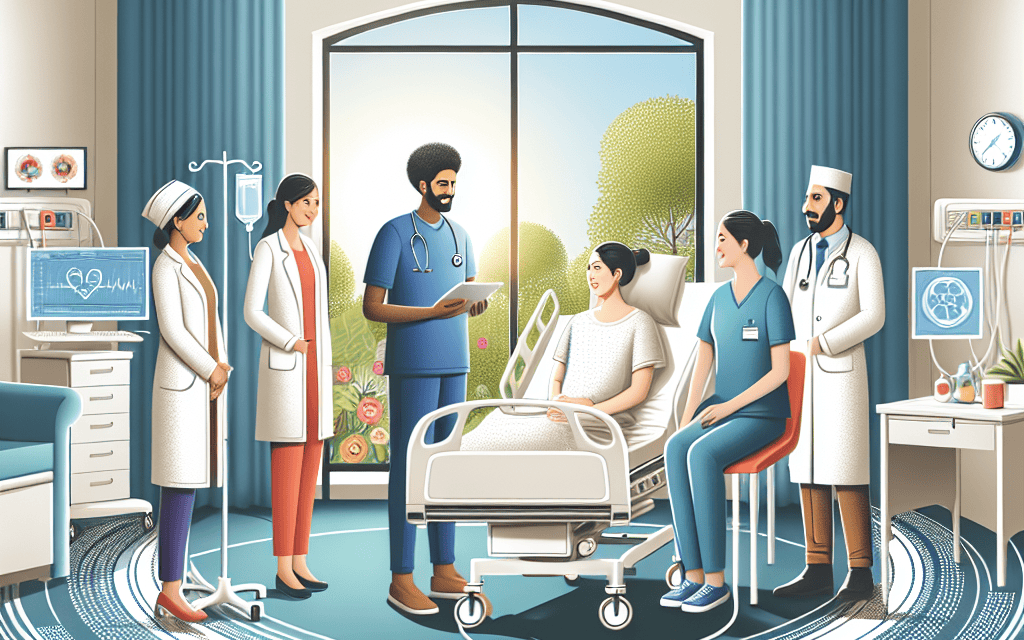Enhancing Patient Experience: Unlocking Unexpected Benefits
In the ever-evolving landscape of healthcare, enhancing patient experience has emerged as a critical focus for providers, administrators, and policymakers alike. The patient experience encompasses every interaction a patient has with the healthcare system, from scheduling appointments to receiving treatment and follow-up care. As healthcare organizations strive to improve this experience, they unlock a myriad of unexpected benefits that extend beyond patient satisfaction. This article delves into the multifaceted aspects of enhancing patient experience, exploring its significance, strategies for improvement, and the unexpected advantages that arise from prioritizing patient-centered care.
The Importance of Patient Experience in Healthcare
Understanding the importance of patient experience is the first step toward enhancing it. A positive patient experience is not merely a luxury; it is a necessity that can significantly impact health outcomes, patient loyalty, and the overall efficiency of healthcare systems.
1.1 Impact on Health Outcomes
Research has consistently shown that a positive patient experience correlates with better health outcomes. When patients feel valued and understood, they are more likely to adhere to treatment plans, attend follow-up appointments, and engage in preventive care. A study published in the Journal of Patient Experience found that patients who reported higher satisfaction levels were more likely to achieve better clinical outcomes, including lower rates of hospital readmissions.
1.2 Financial Implications
Enhancing patient experience can also lead to significant financial benefits for healthcare organizations. Satisfied patients are more likely to return for future care and recommend the facility to others, driving patient volume and revenue. According to a report by the Advisory Board, hospitals that excel in patient experience can see a revenue increase of up to 10% due to higher patient retention and referrals.
1.3 Regulatory Compliance and Reimbursement
In recent years, regulatory bodies have placed a greater emphasis on patient experience as a metric for quality care. Programs like the Hospital Consumer Assessment of Healthcare Providers and Systems (HCAHPS) survey directly tie patient satisfaction scores to reimbursement rates. Facilities that fail to meet certain benchmarks may face financial penalties, making it imperative for organizations to prioritize patient experience.
1.4 Building Trust and Loyalty
Trust is a cornerstone of the patient-provider relationship. When patients feel respected and cared for, they are more likely to trust their healthcare providers. This trust fosters loyalty, encouraging patients to return for future care and to recommend the provider to friends and family. A study by the Beryl Institute found that 70% of patients would choose a provider based on positive experiences shared by others.
1.5 The Role of Technology
Technology plays a pivotal role in shaping patient experience. From telehealth services to patient portals, technology can enhance communication, streamline processes, and provide patients with greater control over their healthcare journey. A survey by Accenture revealed that 77% of patients are willing to use digital tools to manage their health, highlighting the importance of integrating technology into patient experience strategies.
Strategies for Enhancing Patient Experience
To unlock the benefits of improved patient experience, healthcare organizations must implement effective strategies that prioritize patient needs and preferences. Here are several key approaches that can lead to meaningful enhancements.
2.1 Patient-Centered Care
At the heart of enhancing patient experience is the concept of patient-centered care. This approach emphasizes the importance of understanding and addressing the unique needs of each patient. By involving patients in decision-making and tailoring care plans to their preferences, healthcare providers can create a more personalized experience.
- Shared Decision-Making: Encourage patients to participate in their treatment decisions by providing them with relevant information and options.
- Individualized Care Plans: Develop care plans that consider patients’ lifestyles, values, and preferences, ensuring that treatment aligns with their goals.
- Active Listening: Train healthcare providers to practice active listening, allowing patients to express their concerns and preferences fully.
2.2 Effective Communication
Clear and compassionate communication is essential for enhancing patient experience. Patients who feel informed and understood are more likely to have positive interactions with their healthcare providers.
- Use of Plain Language: Avoid medical jargon and use simple language to explain diagnoses, treatment options, and procedures.
- Regular Updates: Keep patients informed about their care progress, test results, and any changes to their treatment plans.
- Empathy Training: Provide training for healthcare staff on empathetic communication techniques to foster a supportive environment.
2.3 Streamlining Processes
Efficiency in healthcare processes can significantly enhance patient experience. Long wait times and complicated procedures can lead to frustration and dissatisfaction.
- Appointment Scheduling: Implement user-friendly online scheduling systems that allow patients to book appointments at their convenience.
- Reducing Wait Times: Analyze patient flow and identify bottlenecks to streamline processes and minimize wait times.
- Follow-Up Procedures: Establish clear follow-up protocols to ensure patients receive timely communication regarding their care.
2.4 Creating a Welcoming Environment
The physical environment of healthcare facilities plays a crucial role in shaping patient experience. A welcoming and comfortable atmosphere can alleviate anxiety and enhance satisfaction.
- Comfortable Waiting Areas: Design waiting areas with comfortable seating, calming decor, and amenities such as refreshments and entertainment.
- Accessibility: Ensure that facilities are accessible to all patients, including those with disabilities, by providing ramps, elevators, and clear signage.
- Patient Privacy: Create private spaces for consultations and discussions to respect patient confidentiality and comfort.
2.5 Leveraging Technology
Technology can be a powerful ally in enhancing patient experience. By integrating digital tools into care delivery, healthcare organizations can improve communication, access to information, and overall engagement.
- Telehealth Services: Offer telehealth options to provide patients with convenient access to care, especially for follow-up appointments and consultations.
- Patient Portals: Implement secure online portals that allow patients to access their health information, schedule appointments, and communicate with providers.
- Mobile Health Apps: Develop mobile applications that empower patients to track their health, receive reminders, and access educational resources.
Unexpected Benefits of Enhancing Patient Experience
While the primary goal of enhancing patient experience is to improve satisfaction and outcomes, there are several unexpected benefits that can arise from these efforts. These advantages can have far-reaching implications for healthcare organizations and the communities they serve.
3.1 Improved Staff Satisfaction and Retention
Enhancing patient experience often leads to improved staff satisfaction. When healthcare providers feel empowered to deliver high-quality, patient-centered care, they experience greater job satisfaction and engagement.
- Positive Work Environment: A focus on patient experience fosters a culture of collaboration and respect among staff, leading to a more positive work environment.
- Reduced Burnout: When staff members see the positive impact of their work on patient outcomes, it can reduce feelings of burnout and stress.
- Higher Retention Rates: Satisfied staff are more likely to remain with the organization, reducing turnover costs and maintaining continuity of care.
3.2 Enhanced Reputation and Brand Loyalty
A strong commitment to patient experience can enhance the reputation of healthcare organizations. Positive word-of-mouth and online reviews can significantly influence public perception.
- Community Trust: Organizations that prioritize patient experience build trust within their communities, leading to increased patient loyalty and referrals.
- Competitive Advantage: In a crowded healthcare market, a reputation for excellent patient experience can differentiate an organization from its competitors.
- Attracting Talent: A positive reputation can attract top talent, as healthcare professionals seek to work in environments known for high-quality care.
3.3 Increased Patient Engagement
When healthcare organizations prioritize patient experience, they often see increased patient engagement. Engaged patients are more likely to take an active role in their health and well-being.
- Proactive Health Management: Engaged patients are more likely to participate in preventive care and manage chronic conditions effectively.
- Better Communication: Increased engagement leads to improved communication between patients and providers, fostering a collaborative approach to care.
- Higher Satisfaction Scores: Engaged patients tend to report higher satisfaction scores, further enhancing the organization’s reputation.
3.4 Innovation and Continuous Improvement
Focusing on patient experience can drive innovation within healthcare organizations. As providers seek to enhance care delivery, they often identify new solutions and best practices.
- Feedback Loops: Establishing mechanisms for patient feedback encourages continuous improvement and innovation in care delivery.
- Adoption of Best Practices: Organizations that prioritize patient experience are more likely to adopt evidence-based practices that enhance care quality.
- Collaboration with Patients: Engaging patients in the design of services and processes can lead to innovative solutions that better meet their needs.
3.5 Positive Impact on Public Health
Enhancing patient experience can have broader implications for public health. When patients feel satisfied with their care, they are more likely to engage in preventive measures and seek timely treatment.
- Increased Preventive Care: Satisfied patients are more likely to participate in preventive screenings and vaccinations, contributing to overall public health.
- Reduced Health Disparities: By prioritizing patient experience, healthcare organizations can address disparities in care and improve access for underserved populations.
- Community Health Initiatives: Organizations that focus on patient experience are often more involved in community health initiatives, promoting wellness beyond the clinical setting.
Case Studies: Successful Implementation of Patient Experience Strategies
To illustrate the effectiveness of enhancing patient experience, we can examine several case studies of healthcare organizations that have successfully implemented strategies to improve care delivery.
4.1 Virginia Mason Medical Center
Virginia Mason Medical Center in Seattle, Washington, is renowned for its commitment to patient-centered care. The organization adopted the Virginia Mason Production System (VMPS), which emphasizes continuous improvement and efficiency in healthcare delivery.
- Patient-Centered Design: The facility redesigned its physical space to enhance patient flow and comfort, resulting in reduced wait times and improved satisfaction.
- Team-Based Care: Virginia Mason implemented team-based care models that empower healthcare providers to collaborate and focus on patient needs.
- Measurable Outcomes: The organization has seen significant improvements in patient satisfaction scores and clinical outcomes, demonstrating the effectiveness of its patient experience initiatives.
4.2 Cleveland Clinic
Cleveland Clinic is another exemplary case of enhancing patient experience. The organization has made significant investments in technology and communication to improve patient engagement.
- MyChart Patient Portal: Cleveland Clinic’s MyChart portal allows patients to access their health information, schedule appointments, and communicate with providers, leading to increased engagement.
- Patient Experience Training: The organization provides extensive training for staff on empathetic communication and patient-centered care, resulting in higher satisfaction scores.
- Recognition and Awards: Cleveland Clinic has consistently ranked among the top hospitals in the nation for patient experience, showcasing the success of its initiatives.
4.3 Mayo Clinic
Mayo Clinic is widely recognized for its commitment to patient-centered care. The organization has implemented several strategies to enhance patient experience across its facilities.
- Integrated Care Teams: Mayo Clinic utilizes integrated care teams that collaborate to provide comprehensive care tailored to individual patient needs.
- Patient Feedback Mechanisms: The organization actively solicits patient feedback through surveys and focus groups, using this information to drive continuous improvement.
- Holistic Approach: Mayo Clinic emphasizes a holistic approach to care, addressing not only physical health but also emotional and psychological well-being.
Conclusion: The Path Forward for Patient Experience Enhancement
Enhancing patient experience is not just a trend; it is a fundamental shift in how healthcare is delivered. By prioritizing patient needs, healthcare organizations can unlock a multitude of unexpected benefits that extend beyond satisfaction scores. Improved health outcomes, financial gains, and enhanced staff satisfaction are just a few of the advantages that arise from a commitment to patient-centered care.
As healthcare continues to evolve, organizations must embrace innovative strategies that leverage technology, streamline processes, and foster a culture of empathy and collaboration. By doing so, they can create an environment where patients feel valued, engaged, and empowered to take charge of their health.
The journey toward enhancing patient experience is ongoing, but the rewards are well worth the effort. As healthcare providers work to unlock the full potential of patient-centered care, they will not only improve individual experiences but also contribute to the overall health and well-being of their communities.





